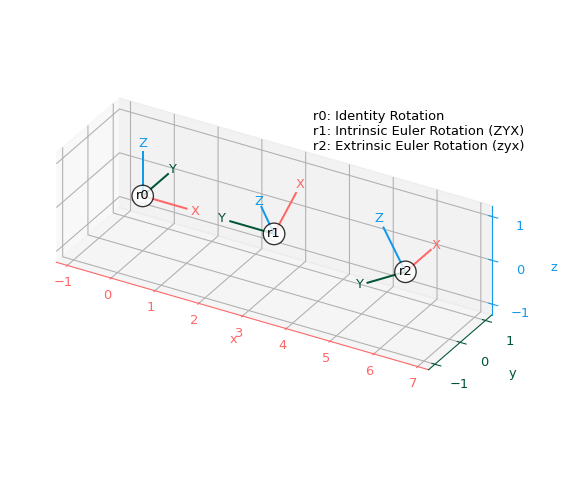Rotation#
- class scipy.spatial.transform.Rotation#
3 维旋转。
此类提供了一个接口,用于从以下对象初始化和表示旋转:
四元数
旋转矩阵
旋转向量
修正的罗德里格参数
欧拉角
达文波特角(广义欧拉角)
支持以下旋转操作
在向量上的应用
旋转组合
旋转求逆
旋转索引
由于多个旋转变换可以存储在单个
Rotation实例中,因此支持旋转内的索引。要创建
Rotation对象,请使用from_...方法(参见以下示例)。Rotation(...)不应该被直接实例化。- 属性:
single (单个)此实例是否表示单个旋转。
方法
__len__(self)此对象中包含的旋转次数。
from_quat(cls, quat, *[, scalar_first])从四元数初始化。
from_matrix(cls, matrix)从旋转矩阵初始化。
from_rotvec(cls, rotvec[, degrees])从旋转向量初始化。
from_mrp(cls, mrp)从修正的罗德里格参数 (MRPs) 初始化。
from_euler(cls, seq, angles[, degrees])从欧拉角初始化。
from_davenport(cls, axes, order, angles[, ...])从达文波特角初始化。
as_quat(self[, canonical, scalar_first])表示为四元数。
as_matrix(self)表示为旋转矩阵。
as_rotvec(self[, degrees])表示为旋转向量。
as_mrp(self)表示为修正的罗德里格参数 (MRPs)。
as_euler(self, seq[, degrees])表示为欧拉角。
as_davenport(self, axes, order[, degrees])表示为达文波特角。
concatenate(cls, rotations)将
Rotation对象的序列连接到单个对象中。apply(self, vectors[, inverse])将此旋转应用于一组向量。
__mul__(self, Rotation other)将此旋转与另一个旋转组合。
__pow__(self, float n, modulus)将此旋转与其自身组合 n 次。
inv(self)反转此旋转。
magnitude(self)获取旋转的幅度。
approx_equal(self, Rotation other[, atol, ...])确定另一个旋转是否与此旋转大致相等。
mean(self[, weights])获取旋转的平均值。
reduce(self[, left, right, return_indices])使用提供的旋转组减少此旋转。
create_group(cls, group[, axis])创建一个 3D 旋转组。
__getitem__(self, indexer)从对象中提取给定索引处的旋转。
identity(cls[, num])获取单位旋转。
random(cls[, num, rng])生成均匀分布的旋转。
align_vectors(cls, a, b[, weights, ...])估计旋转以最佳对齐两组向量。
另请参阅
注意
在 1.2.0 版本中添加。
示例
>>> from scipy.spatial.transform import Rotation as R >>> import numpy as np
Rotation实例可以用上述任何格式初始化,并转换为任何其他格式。底层对象独立于用于初始化的表示形式。考虑绕 z 轴逆时针旋转 90 度。这对应于以下四元数(标量最后格式)
>>> r = R.from_quat([0, 0, np.sin(np.pi/4), np.cos(np.pi/4)])
旋转可以用任何其他格式表示
>>> r.as_matrix() array([[ 2.22044605e-16, -1.00000000e+00, 0.00000000e+00], [ 1.00000000e+00, 2.22044605e-16, 0.00000000e+00], [ 0.00000000e+00, 0.00000000e+00, 1.00000000e+00]]) >>> r.as_rotvec() array([0. , 0. , 1.57079633]) >>> r.as_euler('zyx', degrees=True) array([90., 0., 0.])
相同的旋转可以使用旋转矩阵初始化
>>> r = R.from_matrix([[0, -1, 0], ... [1, 0, 0], ... [0, 0, 1]])
其他格式的表示
>>> r.as_quat() array([0. , 0. , 0.70710678, 0.70710678]) >>> r.as_rotvec() array([0. , 0. , 1.57079633]) >>> r.as_euler('zyx', degrees=True) array([90., 0., 0.])
对应于此旋转的旋转向量由下式给出
>>> r = R.from_rotvec(np.pi/2 * np.array([0, 0, 1]))
其他格式的表示
>>> r.as_quat() array([0. , 0. , 0.70710678, 0.70710678]) >>> r.as_matrix() array([[ 2.22044605e-16, -1.00000000e+00, 0.00000000e+00], [ 1.00000000e+00, 2.22044605e-16, 0.00000000e+00], [ 0.00000000e+00, 0.00000000e+00, 1.00000000e+00]]) >>> r.as_euler('zyx', degrees=True) array([90., 0., 0.])
from_euler方法在它支持的输入格式范围内非常灵活。这里我们初始化一个绕单个轴的单次旋转>>> r = R.from_euler('z', 90, degrees=True)
同样,该对象与表示形式无关,可以转换为任何其他格式
>>> r.as_quat() array([0. , 0. , 0.70710678, 0.70710678]) >>> r.as_matrix() array([[ 2.22044605e-16, -1.00000000e+00, 0.00000000e+00], [ 1.00000000e+00, 2.22044605e-16, 0.00000000e+00], [ 0.00000000e+00, 0.00000000e+00, 1.00000000e+00]]) >>> r.as_rotvec() array([0. , 0. , 1.57079633])
还可以使用任何
from_...函数在单个实例中初始化多次旋转。 这里我们使用from_euler方法初始化 3 个旋转的堆栈>>> r = R.from_euler('zyx', [ ... [90, 0, 0], ... [0, 45, 0], ... [45, 60, 30]], degrees=True)
其他表示形式现在也返回 3 个旋转的堆栈。例如
>>> r.as_quat() array([[0. , 0. , 0.70710678, 0.70710678], [0. , 0.38268343, 0. , 0.92387953], [0.39190384, 0.36042341, 0.43967974, 0.72331741]])
将上述旋转应用于向量
>>> v = [1, 2, 3] >>> r.apply(v) array([[-2. , 1. , 3. ], [ 2.82842712, 2. , 1.41421356], [ 2.24452282, 0.78093109, 2.89002836]])
Rotation实例可以像单个一维数组或列表一样进行索引和切片>>> r.as_quat() array([[0. , 0. , 0.70710678, 0.70710678], [0. , 0.38268343, 0. , 0.92387953], [0.39190384, 0.36042341, 0.43967974, 0.72331741]]) >>> p = r[0] >>> p.as_matrix() array([[ 2.22044605e-16, -1.00000000e+00, 0.00000000e+00], [ 1.00000000e+00, 2.22044605e-16, 0.00000000e+00], [ 0.00000000e+00, 0.00000000e+00, 1.00000000e+00]]) >>> q = r[1:3] >>> q.as_quat() array([[0. , 0.38268343, 0. , 0.92387953], [0.39190384, 0.36042341, 0.43967974, 0.72331741]])
事实上,它可以转换为 numpy.array
>>> r_array = np.asarray(r) >>> r_array.shape (3,) >>> r_array[0].as_matrix() array([[ 2.22044605e-16, -1.00000000e+00, 0.00000000e+00], [ 1.00000000e+00, 2.22044605e-16, 0.00000000e+00], [ 0.00000000e+00, 0.00000000e+00, 1.00000000e+00]])
可以使用
*运算符组合多个旋转>>> r1 = R.from_euler('z', 90, degrees=True) >>> r2 = R.from_rotvec([np.pi/4, 0, 0]) >>> v = [1, 2, 3] >>> r2.apply(r1.apply(v)) array([-2. , -1.41421356, 2.82842712]) >>> r3 = r2 * r1 # Note the order >>> r3.apply(v) array([-2. , -1.41421356, 2.82842712])
可以使用
**运算符将旋转与其自身组合>>> p = R.from_rotvec([1, 0, 0]) >>> q = p ** 2 >>> q.as_rotvec() array([2., 0., 0.])
最后,也可以反转旋转
>>> r1 = R.from_euler('z', [90, 45], degrees=True) >>> r2 = r1.inv() >>> r2.as_euler('zyx', degrees=True) array([[-90., 0., 0.], [-45., 0., 0.]])
以下函数可用于通过显示旋转如何变换标准 x、y、z 坐标轴,使用 Matplotlib 绘制旋转
>>> import matplotlib.pyplot as plt
>>> def plot_rotated_axes(ax, r, name=None, offset=(0, 0, 0), scale=1): ... colors = ("#FF6666", "#005533", "#1199EE") # Colorblind-safe RGB ... loc = np.array([offset, offset]) ... for i, (axis, c) in enumerate(zip((ax.xaxis, ax.yaxis, ax.zaxis), ... colors)): ... axlabel = axis.axis_name ... axis.set_label_text(axlabel) ... axis.label.set_color(c) ... axis.line.set_color(c) ... axis.set_tick_params(colors=c) ... line = np.zeros((2, 3)) ... line[1, i] = scale ... line_rot = r.apply(line) ... line_plot = line_rot + loc ... ax.plot(line_plot[:, 0], line_plot[:, 1], line_plot[:, 2], c) ... text_loc = line[1]*1.2 ... text_loc_rot = r.apply(text_loc) ... text_plot = text_loc_rot + loc[0] ... ax.text(*text_plot, axlabel.upper(), color=c, ... va="center", ha="center") ... ax.text(*offset, name, color="k", va="center", ha="center", ... bbox={"fc": "w", "alpha": 0.8, "boxstyle": "circle"})
创建三个旋转 - 使用固有和外在约定的单位旋转和两个欧拉旋转
>>> r0 = R.identity() >>> r1 = R.from_euler("ZYX", [90, -30, 0], degrees=True) # intrinsic >>> r2 = R.from_euler("zyx", [90, -30, 0], degrees=True) # extrinsic
将所有三个旋转添加到单个图中
>>> ax = plt.figure().add_subplot(projection="3d", proj_type="ortho") >>> plot_rotated_axes(ax, r0, name="r0", offset=(0, 0, 0)) >>> plot_rotated_axes(ax, r1, name="r1", offset=(3, 0, 0)) >>> plot_rotated_axes(ax, r2, name="r2", offset=(6, 0, 0)) >>> _ = ax.annotate( ... "r0: Identity Rotation\n" ... "r1: Intrinsic Euler Rotation (ZYX)\n" ... "r2: Extrinsic Euler Rotation (zyx)", ... xy=(0.6, 0.7), xycoords="axes fraction", ha="left" ... ) >>> ax.set(xlim=(-1.25, 7.25), ylim=(-1.25, 1.25), zlim=(-1.25, 1.25)) >>> ax.set(xticks=range(-1, 8), yticks=[-1, 0, 1], zticks=[-1, 0, 1]) >>> ax.set_aspect("equal", adjustable="box") >>> ax.figure.set_size_inches(6, 5) >>> plt.tight_layout()
显示该图
>>> plt.show()

这些示例概述了
Rotation类并突出显示了主要功能。 有关支持的输入和输出格式范围的更详尽示例,请查阅各个方法的示例。